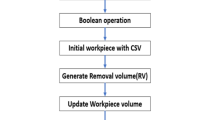Abstract
Manufacturers produce complex parts by utilizing computer-aided manufacturing (CAM) software to generate tool paths for a machine tool to follow. CAM systems traditionally rely on parametric surface representations of the parts and complex algorithms to produce the tool paths. This paper presents a new path generation framework that is based on parallel algorithms and hardware that utilizes voxel models. The use of new parallel algorithms allows rapid calculations of tool paths automatically from the voxel model. The core components of this framework are a method of generating digital voxel models from tessellated surface models, a method to obtain digital surface information by a parallel ray-casting approach, and a new approach to calculate gouge-free tool paths in parallel from surface information and generalized cutting geometry. The performance of utilizing digital models within this framework is then discussed with respect to timing and actual cutting results.
Similar content being viewed by others
References
Broomhead P, Edkins M (1986) Generating NC data at the machine tool for the manufacture of free-form surfaces. Int J Prod Res 24(1):1–14
Elber G, Cohen E (1993) Tool path generation for freeform surface models. Proceedings on the second ACM symposium on solid modeling and applications, 1993. pp 419–428
Loney GC, Ozsoy TM (1987) NC machining of free form surfaces. Comput-Aided Des 19(2):85–90
Bobrow JE (1985) NC machine tool path generation from CSG part representations. Comput-Aided Des 17(2):69–76
Huang Y, Oliver JH (1994) Non-constant parameter NC tool path generation on sculptured surfaces. Int J Adv Manuf Technol 9(5):281–290
Hwang JS (1992) Interference-free tool-path generation in the NC machining of parametric compound surfaces. Comput-Aided Des 24(12):667–676
Kim S-J, Yang M-Y (2006) A CL surface deformation approach for constant scallop height tool path generation from triangular mesh. Int J Adv Manuf Technol 28:314–320
Suresh K, Yang DCH (1994) Constant scallop-height machining of free-form surfaces. J Eng Ind 116(2):253–259
Yuwen S et al (2006) Iso-parametric tool path generation from triangular meshes for free-form surface machining. Int J Adv Manuf Technol 28(7):721–726
Yang DCH et al (2003) Boundary-conformed toolpath generation for trimmed free-form surfaces via Coons reparametrization. J Mater Process Tech 138(1–3):138–144
Park S, Choi BK (2000) Tool-path planning for directio-parallel area milling. Comput-Aided Des 32(1):17–25
Kim BH, Choi BK (2000) Guide surface based tool path generation in 3-axis milling: an extension of the guide plane method. Comput-Aided Des 32(3):191–199
Ding S et al (2003) Adaptive iso-planar tool path generation for machining of free-form surfaces. Comput-Aided Des 35(2):141–153
Lasemi A, Xue D, Gu P (2010) Recent development in CNC machining of freeform surfaces: a state-of-the-art review. Comput-Aided Des 42(7):641–654
Duncan JP, Mair SG (1983) Sculptured surfaces in engineering and medicine. Cambridge University Press, New York
Jun CS, Kim DS, Park S (2002) A new curve-based approach to polyhedral machining. Comput-Aided Des 34(5):379–389
Choi BK, Jun CS (1989) Ball-end cutter interference avoidance in NC machining of sculptured surfaces. Comput-Aided Des 21(6):371–378
Choi BK et al (1988) Compound surface modelling and machining. Comput-Aided Des 20(3):127–136
Choi BK, Km DH, Jerad RB (1997) C-space approach to tool-path generation for die and mold machining. Comput-Aided Des 29(9):657–669
Takeuchi Y et al (1989) Development of a personal CAD/CAM system for mold manufacture based on solid modeling techniques. Ann CIRP 38(1):429–432
Inui M (2003) Fast inverse offset computation using polygon rendering hardware. Computer-Aided Design 35(2):191–201
nVIDIA (2013) GPU accelerated research. http://www.nvidia.com/object/cuda_home.html. Accessed 25 Sept 2009
Hwu WM et al (2009) Compute unified device architecture application suitability. Comput Sci Eng 11:16–26
McMains S, Kardekar R, Burton G (2006) Finding feasible mold parting directions using graphics hardware. Comput-Aided Des 38(4):327–341
Gray PJ, Ismail F, Bedi S (2004) Graphics-assisted rolling ball method for 5-axis surface machining. Comput-Aided Des 36:653–663
Gray P, Ismail F, Bedi S (2004) Arc-intersect method for 5-axis tool positioning. Comput-Aided Des 37:663–674
Dokken T, Hagen TR, Hjelmervik JM (2005) The GPU as a high performance computational resource. Proceedings of the 21st spring conference on Computer graphics, 2005. p 21–26
Roth D, Ismail F, Bedi S (2005) Mechanistic modelling of the milling process using complex tool geometry. Int J Adv Manuf Technol 25(1):140–144
Roth D, Ismail F, Bedi S (2003) Mechanistic modeling of the milling process using an adaptive depth buffer. Comput-Aided Des 35:1287–1303
Inui M, Ohta A (2007) Using a GPU to accelerate die and mold fabrication. IEEE Comput Graph Appl 27:82–88
Carter JA, Tucker TM, Kurfess TR (2008) 3-Axis CNC path planning using depth buffer and fragment shader. Comput-Aided Des Appl 5(5):612–621
Stone SS et al (2008) Accelerating advanced MRI reconstructions on GPUs. J Parallel Distr Comp 68(10):1307–1318
Appel A (1968) Some techniques for shading machine renderings of solids. In Proceedings of the AFIPS Joint Computer Conferences. 1968. Atlantic City, New Jersey
Cook RL, Porter T, Carpenter L (1984) Distributed ray tracing. ACM SIGGRAPH Comput Graphics 18(3):137–147
Roth SD (1982) Ray casting for modeling solids. Comput Graph Image Process 18:109–144
Glassner (1995) Principles of digital image synthesis. Morgan Kaufman, San Francisco
Griffiths (1994) Toolpath Hilbert's curve 26(11):839–844
D Zhang, Bowyer A (1986) CSG set-theoretic solid modelling and NC machining of blend surfaces. In Proceedings of the second Annual Symposium on Computational Geometry. 1986. Yorktown Heights, New York
Jang D, Kim K, Jung J (2000) Voxel-based virtual multi-axis machining. Int J Adv Manuf Technol 16(10):709–713
Engle K et al (2006) Real-time volume graphics. A K Peters, Ltd., Wellesley
Chiou CJ, Lee YS (1999) A shape-generating approach for multi-axis machining G-buffer models. Comput-Aided Des 31(12):761–776
Author information
Authors and Affiliations
Corresponding author
Rights and permissions
About this article
Cite this article
Tarbutton, J., Kurfess, T.R., Tucker, T. et al. Gouge-free voxel-based machining for parallel processors. Int J Adv Manuf Technol 69, 1941–1953 (2013). https://doi.org/10.1007/s00170-013-5148-x
Received:
Accepted:
Published:
Issue Date:
DOI: https://doi.org/10.1007/s00170-013-5148-x




